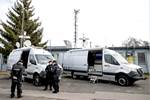Composite integral fuel tank for hydrogen storage in aircraft developed via Czech Republic project
Made using CompoTech’s robot-assisted winding technology, the Type 4 or 5 multi-cell tank is designed to be integrated into an aircraft wing root.
Simplified technology sample for composite multicell integral tank being developed in the Czech Republic for aviation. Source | CompoTech
Running from March 2023 to December 2025, the research project titled “Composite integral fuel tank for pressurised hydrogen” is supported by the Technology Agency of the Czech Republic and funded as sub-project TN02000009/06 within the main research project: National Competence Centre for Aeronautics and Space, NaCCAS II. It includes three main partners:
- Czech Technical University in Prague
- Filament winding specialist CompoTech PLUS, spol. s r.o. (Sušice)
- Aircraft manufacturer Distar CZ a.s. (Nový Bydžov)
The goal of the project is to produce a functional demonstrator for a compressed gaseous hydrogen (CGH2) fuel tank made with a non-standard shape, able to carry loads from the primary structure of a general aviation-type aircraft. This tank will be a Type 4 or linerless Type 5 design, driven by the two crucial criteria to minimize mass and maximize safety.
After considering locating the tank in the wing or tail, the wing was chosen as more beneficial. Placed near the wing root section, the tank’s high axial strength will help transfer bending moment from the airplane primary structure as well as some torsional loading.
As explained by project manager Robin Poul, R&D specialist at CompoTech, the tank will be produced using the company’s robot-assisted fiber laying (RAFL) technology, derived from filament winding but with more controlled machine axes enabling more precise placement of fibers on complex shapes and fiber positioning along the product’s main axis — i.e., in 0° orientations, not typically possible with traditional filament winding.
“The tank will have a relatively complex shape determined by maximum use of the aircraft wing’s internal space,” says Poul. “The result is a flat, airfoil-like, non-prismatic geometry.”
Simplified technology samples have been fabricated, targeting production in 2025. The functional demonstrator will be roughly 2.5 meters long — other dimensions are still being finalized. It will be made using carbon fiber and epoxy resin with three options being considered to meet permeability resistance requirements:
- Standard epoxy resin
- Non-standard resin with improved barrier properties
- Thermoplastic liner — in which case, the tank will be Type 4.
The choice will depend on results from the preliminary technology sample tests. The tank’s multiple walls will result from each cavity having its own winding mandrel, says Poul. These will then be overwound with outer layers to form an integrated structure. The mandrels will be removed after cure. After this first step, the end caps will be added, followed by final winding and placement of the axial fibers, and then final cure.
Once completed, the demonstrator tank will undergo pressure tests with water targeting a burst pressure of 800 bar and permeation tests with CGH2 at a working pressure of 350 bar, as well as bending and torsional tests. Poul believes the project should succeed in a continuation phase to run from 2026-2028 with the goal to integrate the pressure vessel into the wing root of an actual aircraft.
Related Content
-
Composites end markets: Automotive (2024)
Recent trends in automotive composites include new materials and developments for battery electric vehicles, hydrogen fuel cell technologies, and recycled and bio-based materials.
-
Toray announces growth, investment in carbon fiber composite materials
As part of its 2023-2025 management strategy, Toray projects 42% growth for pressure vessels, 30% growth in carbon fiber composite materials revenue and a doubling of capital investment.
-
Cryo-compressed hydrogen, the best solution for storage and refueling stations?
Cryomotive’s CRYOGAS solution claims the highest storage density, lowest refueling cost and widest operating range without H2 losses while using one-fifth the carbon fiber required in compressed gas tanks.
















